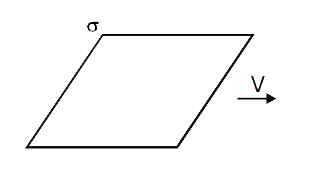An infinitely large plate of surface charge density +σ is lying in horizontal xy-plane. A particle having charge −q0 and mass m is projected from the plate with velocity u making an angle θ with sheet. Find :

(i) The time taken by the particle to return on the plate.
(ii) Maximum height achieved by the particle.
(iii) At what distance will it strike the plate (Neglect gravitational force on the particle)

Electric force acting on the particle Fe=qoE:Fe=(qo)(σ2εo) downward
So, acceleration of the particle : a=Fem=qoσ2εom= uniform
This acceleration will act like 'g' (acceleration due to gravity)
So, the particle will perform projectile motion.
(i) T=2usinθg=2usinθ(qoσ2εom) (ii) H=u2sin2θ2g=u2sin2θ.2(qoσ2εom)
(iii) R=u2sin2θg=u2sin2θ(qoσ2εom)
Topper's Solved these Questions
- BOOK - RESONANCECHAPTER - ELECTROSTATICSEXERCISE - Problems22videos
ELECTROSTATICS
- BOOK - RESONANCECHAPTER - ELECTROSTATICSEXERCISE - Exercise-1 Section (A)9videos
ELECTROSTATICS
- BOOK - RESONANCECHAPTER - ELECTROMAGNETIC INDUCTIONEXERCISE - A.l.P19videos
ELECTROMAGNETIC INDUCTION
- BOOK - RESONANCECHAPTER - EXPERIMENTAL PHYSICSEXERCISE - PART -II10videos
EXPERIMENTAL PHYSICS
Similar Questions
An infinitely large plate of surface charge density +σ lying in horizontal xy plane. A particle having charge −q0 and mass m is projected from the plate with velocity u making an angle θ with sheet. Find :

(i) the time taken by the particle to return on the plate.
(ii) maximum height achieved by the particle.
(iii) At what distance will it strike the plate (Neglect gravitational force on the particle)View SolutionA particle of charge q and mass m is prjected in a uniform and contant magnetic field of strength B.The initial velocity →v makes angle θ with the →B.Find the distance travelled by the particle in time t.
View Solution
Knowledge Check
- Question 1 - Select One
A particle of mass 'm' is projected from ground with velocity u making angle θ with the vertical. The de-Broglie wave length of the particle at the highest point is:
A∞BhmusinθChmucosθDhmu - Question 2 - Select One or More
A large plate with uniform surface charge density σ is moving with constant speed v as shown in the figure. The magnetic field at a small distance from plate is
 Aμ0σv in magnitudeBμ0σv2 in magnitudeCperpendicular to plateDparallel to plate
Aμ0σv in magnitudeBμ0σv2 in magnitudeCperpendicular to plateDparallel to plate - Question 3 - Select One
A particle projected with velocity u at angle θ with horizontal at t=0. What is the magnitude of change in the velocity of the particle when it is at maximum height?
Aucosθ2BucosθCusinθDnone of these
A particle of mass m projected horizontally with velocity u. if it makes an angle θ with the horizontal after some time, then at that instant, its be Broglie wavelength is
View SolutionA particle having mass m is projected with a velocity v0 from a point P on a horizontal ground making an angle θ with horizontal. Find out the torque about the point of projection acting on the particle when
it is at its maximum height ?
 View Solution
View SolutionA particle is projected with velocity u at angle θ with horizontal. Find the time when velocity vector is perpendicular to initial velocity vector.
View SolutionA particle is projected from horizontal making an angle of 53∘ with initial velocity 100ms−1. The time taken by the particle to make angle 45∘ from horizontal is
View SolutionA particle of mass m is projected with an initial velocity U at an angle θ to the horizontal. The torque of gravity on projectile at maximum height about the point of projection is
View Solution
